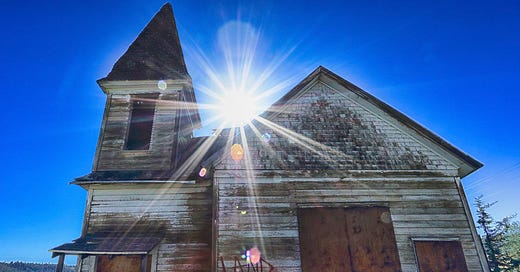While this version of #churchlandback is a bit of a head-shaker, it is still worth our attention in the series. It warns against some cautionary pitfalls to be aware of on the journey.
While living on Vancouver Island, I drove into Duncan once a week through the Cowichan reserve. On the way, I passed by a gutted and abandoned church building on the hillside. My assumption was that this was part of the reserve and that Cowichan Nation, due probably to low attendance and lack of interest, had allowed this building to fall into disrepair. However, that was not the case. Nor is it the case on most reserves.
While most reserves will have at least one church building on their land, it usually does not belong to the Nation. Instead, it almost always belongs to the denomination. When reserves were set up, land was allocated for church buildings. In the West, there was usually a process whereby government agents and denominational leadership determined which reserves were the territory of which denominations. The oldest church building on a reserve usually tells something of the story of who got priority for missions in that area.
"Land back" is painted on a crumbling, abandoned church located on Oregon's Warm Springs Indian Reservation, June 25, 2022. (Flickr/Ian Sane, CC BY 2.0).
Some denominations have begun to turn ownership of the church building and property over to the reserves where they are located. While that might seem to make sense, it isn’t that easy. In British Columbia, until May 21st, 2024, when Bill 13 – The Land Title and Property Amendment Act, went into effect, “unless enabled by specific legislation, such as through treaties or other federal legislation, the majority of First Nations in B.C. were unable to acquire, hold and dispose of land, such as fee simple land and leaseholds in their own names. To buy or hold land, most First Nations had to undertake the additional administrative processes of setting up a corporation or use alternative arrangements, for example, proxies, federal trust, societies and individual members.”1
With the new amendment to the Act, land transfers can now occur unimpeded—at least from a legal perspective.
On Vancouver Island, there is a case of a denomination returning church property to the nation on whose land the church existed. The nation was happy to receive the property. Decision-making about what would happen with the land and building now was fully in their hands. However, when the first insurance payment came due, another problem became evident.
The newly assessed insurance rate was astronomical! This was due to a variety of factors:
As with all insurance, when the pool of coverage shrinks, premiums go up, but this was well beyond the bounds of normal increases of this sort.
There had been a recent rash of church buildings being burned down, especially on reserves, thereby increasing risk.
These increases were significant enough that they made owning and maintaining the building untenable for the community. But this is where a return of land in service of repair of relationship doesn’t just turn over the keys and move on feeling good about having righted a wrong. In this case, the Anglican diocese involved stayed in relationship, discovered that their gift had become a burden and then set about to remove the burden. An arrangement was worked out whereby the diocese was able to reconfigure the insurance arrangement, and then they committed to carrying the insurance premiums. This continued partnership moves the relationship toward greater repair. It highlights the importance of staying aware of impacts and remaining in dialogue throughout the whole process of any landback situation.
This change in BC law, which has permitted land ownership by nations without the bureaucratic hoop-jumping of incorporating or forming a trust, does not apply across the country and continues to create a barrier and a burden upon Indigenous communities, which have no legal framework that permits the return of land. As with BC, we need to see these laws change across the country, or #landback will not even be a viable option.
Next week, we will examine a situation in which a church returned a section of property that had been purchased and then not used for future development. What has developed on that land is literally sweet!
From the BC government website accessed August 6, 2024 https://www2.gov.bc.ca/gov/content/environment/natural-resource-stewardship/consulting-with-first-nations/first-nations-and-land-registration#





So interesting! It is good to hear that some of the churches/denominations are doing their best to set things right.